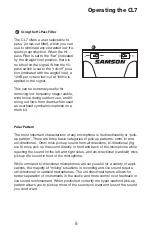
Operating the CL7
4
Powering the CL7
The CL7 is a condenser microphone and therefore needs to be operated by
connecting a phantom power supply. Phantom power is standard on most quali-
ty mixers, outboard mic-pres and hard disk recorders. If necessary, an external
phantom supply can also be used. The CL7 receives the phantom power direct-
ly from a mic cable when connected to a mixer or other microphone input that
includes a phantom supply. The power is sent OUT of the microphone INPUT,
riding silently along with the audio signal. (Fairly mysterious, eh?) Most mixers
have a switch to engage the phantom power so be sure to check that the phan-
tom power is on.
Setting Up the Signal Level
When connecting the CL7 to a mixer or recorder input, be sure that the input is
of microphone level. Also, be sure that the phantom power is engaged as
explained the previous section “Powering the CL7”. Most mixers and recorders
of reasonable quality will offer a microphone input with mic trim (usual called
Trim or Gain) control. The purpose of the mic trim control is to optimize the
amount of good signal to any noise associated with the mixers electronics. A
good mic pre with trim also will have a PEAK or CLIP LED. To set a good level
on the mic, set the CL7 up in front of the desired sound source and slowly raise
the mic trim control until you see the PEAK LED light up. Then, turn the mix
trim control down until the LED does not light any more. On most mixers, the
ideal setting is that the trim control is turned up as much as possible without
lighting the PEAK LED.
Using the PAD Switch
The CL7 includes a PAD switch, which
you can use to lower the input sensitiv-
ity of the microphone. When the PAD
switch is set to the 0dB position the
PAD is by-passed and there is no
effect on the signal. When the PAD
switch is set to the –10dB position, the
microphone’s input sensitivity will be
lowered by 10dB. You can use the
PAD when you are miking loud sound
sources with a high SPL (Sound
Pressure Level).
10
1
1


























